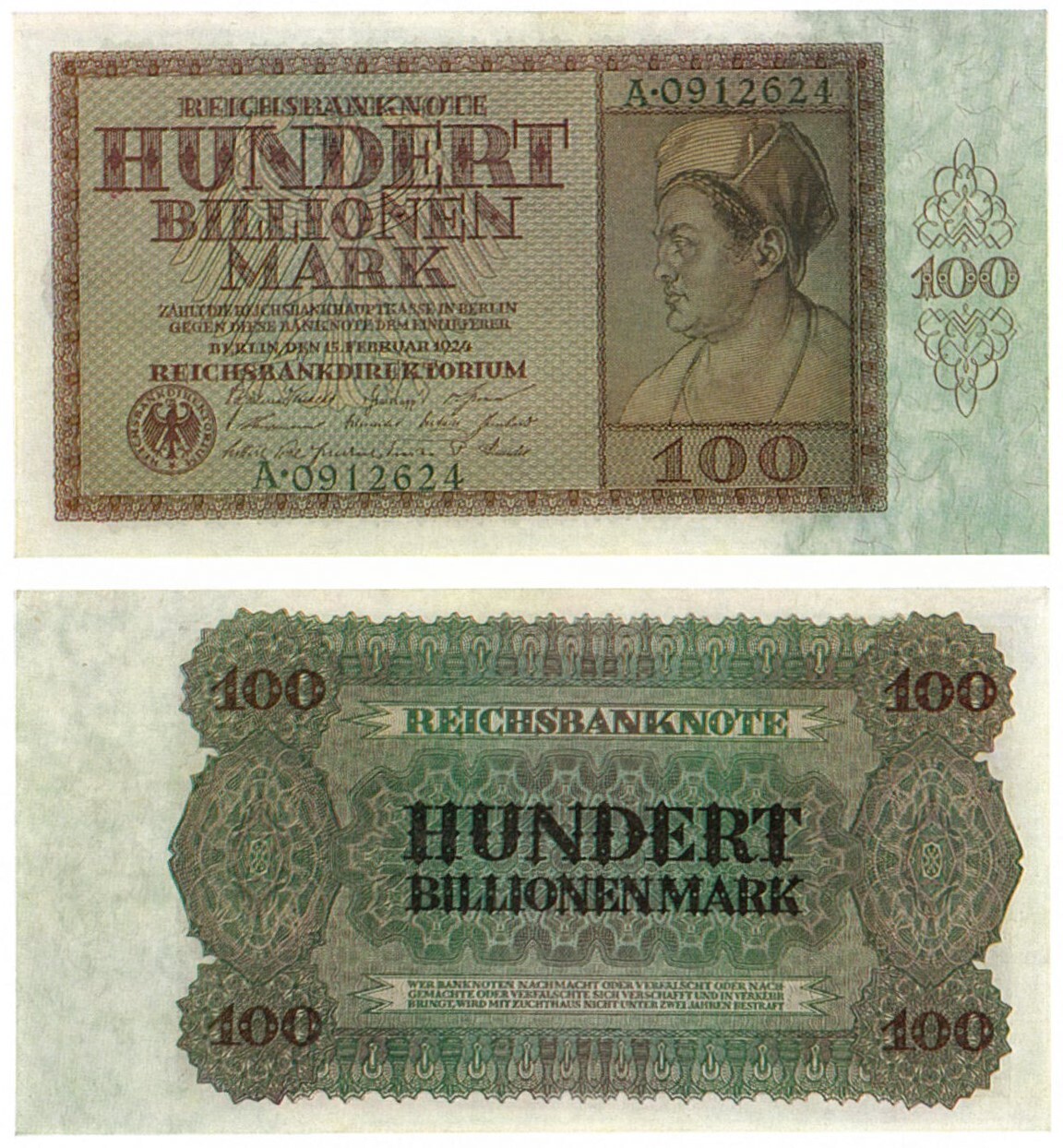- Extreme devaluation of money 100 years ago in the German Reich
- Highest banknote put into circulation was worth 100 trillion marks
- Fourfold increase in staff at the Reichsdruckerei, the predecessor of the Bundesdruckerei
- Additional land and buildings rented for the required paper volumes
In November 1923, a kilogram of rye bread in Berlin cost 233 billion marks, a kilo of beef 4.8 trillion marks: it was the time of hyperinflation, when the mark lost value virtually every hour. Germans carried them by the wash basket to the shops. The economy was in the doldrums after the First World War, the state was heavily in debt and printed money to pay its debts. Inflation rose to such an extent that new banknotes with ever higher denominations had to be printed.
The Reichsdruckerei – the predecessor of today’s Bundesdruckerei – issued a total of 28 different types of banknotes between 25 July 1923 and 26 October 1923 alone. The highest denomination ever used – at that time and to this day – was the banknote for 100 trillion marks, written out as 100,000,000,000,000. On the banknote itself, the written-out number was missing. In February 1924, the Reichsdruckerei even produced a 1,000 trillion mark note, i.e. a quadrillion. However, it never came into circulation because in the meantime it was decided to leave it at a new edition of the 100 trillion mark banknote with improved counterfeit protection.
Security against counterfeiting became secondary
At that time, the security of the notes was not all that good, although every effort was made to ensure it, especially with higher denominations. But every hurdle to note counterfeiting – such as watermarks in the paper – meant more effort for banknote production, which was already working at the limit. “Ever larger amounts of money were needed,” writes postal historian Gerd Gnewuch in his book “100 Years of the Federal Printing Office”. “In the summer of 1922, the Reichsdruckerei of necessity switched to printing banknotes from continuous web paper on rotary presses. Questions of counterfeit protection were secondary.”
It is true that the Reichsdruckerei quadrupled the number of employees during the period to more than 12,000, compared to its workforce before the First World War. But it was not only the staff that became scarce – the machines and rooms of the Reichsdruckerei were also insufficient to print the huge amounts of money. The government therefore commissioned 60 private companies as auxiliary printing works to produce money, as can be seen from the chronicle of the Bundesdruckerei. However, the Reichsdruckerei supervised them and also designed the new notes. There was no time for elaborate security features. “In the summer and autumn of 1923, the private printing trade, which was largely involved in the production, began to mass-produce notes of the simplest printing technology on a scale that could hardly be overlooked,” says Gnewuch.
Reichsdruckerei rented buildings to store the paper for money production
So much paper was needed for money production that the Reichsdruckerei had to rent numerous properties and buildings to store it. At the height of the hyperinflation, in the last three months of 1923, 5.5 million kilograms of paper were processed into banknotes – a year earlier, 3.5 million kilograms had been produced in the same period.
The foundation of Rentenbank stabilises the currency
The banknote excess was ended by the then Reich Chancellor Gustav Stresemann with the introduction of the Rentenmark in November 1923. The exchange ratio of this transitional currency to the previous paper mark was one to one trillion. The first notes of one Rentenmark each were delivered by Reichsdruckerei in December 1923, as can be seen from Bundesdruckerei’s company chronicle. The rapid decline in the value of money came to a halt. Consequently, the Reichsdruckerei’s workload dropped abruptly at the end of 1924. Postal and stamp printing also declined to a normal level. As a result, workshops were merged, worn-out machines were scrapped and the Reichsdruckerei reduced its workforce to just under 3,900.
Bundesdruckerei’s corporate chronicle is available from bookshops: Kamp, Michael; Stieffenhofer, Linda; Stähle, Mascha; Forstner, Thomas: Identität und Sicherheit. From state printer to partner for secure digitisation. The history of the Bundesdruckerei from 1763 to today. Munich 2019.





